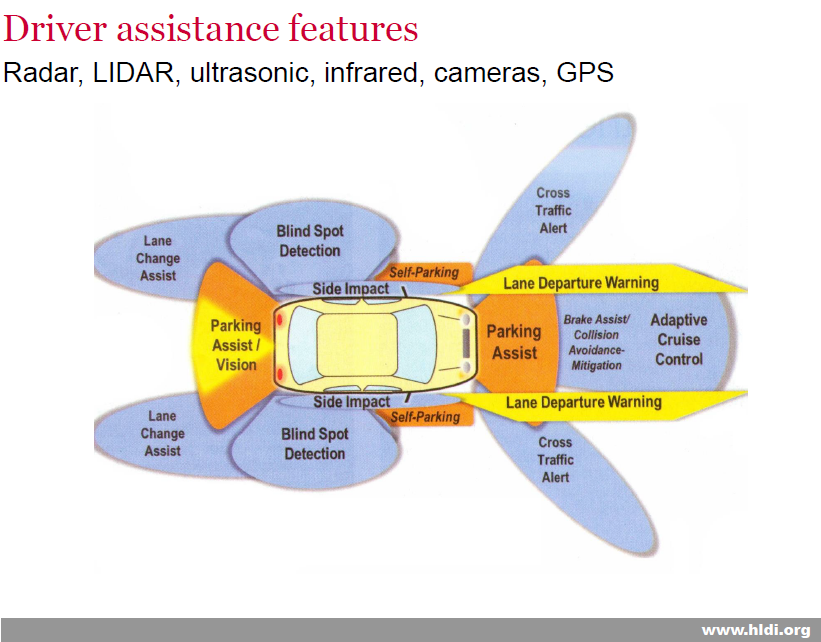
Are you (or someone you know) looking for a new car? If so, safety is probably one of the key criteria in the selection of your next vehicle. Perhaps no other organization has done more to positively impact motor vehicle safety than the Insurance Institute for Highway Safety (IIHS) and the Highway Loss Data Institute (HLDI). Matt Moore, Vice President of HLDI provided an informative session on how IIHS-HLDI have contributed to the decline of motor vehicle crash injuries since the founding of the IIHS in 1959 through influencing car manufacturers to increase vehicle crashworthiness and develop adaptive system control technologies that help prevent accidents.
Historically, IIHS-HLDI's efforts focused on rating vehicle crashworthiness (through various simulated vehicle crashes) and publishing those results for the public. Moore reported that initially car manufacturers by in large ignored the test results but eventually not only took steps to improve vehicle crashworthiness, but also started incorporating safety results in their advertising.
With the advent of adaptive system control technologies that aim to prevent vehicle crashes by either warning drivers to take corrective action or actually taking control of steering, acceleration, or braking to prevent accidents, IIHS-HLDI's testing has expanded to include evaluation of those adaptive systems. Moore provided an overview of the development and maturation of many of these technologies as well as results of HLDI's evaluation of those systems.
 Autonomous (Self-Driving) Cars - Have you heard of the "Google Car?" Google launched a project to develop a driverless car and has made tremendous strides toward that goal. However, according to Moore, the reality is we probably won't be seeing cars coming at us sans driver any time soon. In fact, only four states have enacted legislation allowing autonomous vehicles on the road (and that is limited to research and testing purposes). Additionally, many countries have passed laws requiring vehicles have drivers who are in 'control of the vehicle at all times.'
Autonomous (Self-Driving) Cars - Have you heard of the "Google Car?" Google launched a project to develop a driverless car and has made tremendous strides toward that goal. However, according to Moore, the reality is we probably won't be seeing cars coming at us sans driver any time soon. In fact, only four states have enacted legislation allowing autonomous vehicles on the road (and that is limited to research and testing purposes). Additionally, many countries have passed laws requiring vehicles have drivers who are in 'control of the vehicle at all times.'
So if not cars to take us from point A to point B via a smart phone app, what are we likely to see the next time we visit our local dealership? You might find one or some combination of all of these adaptive control system technologies.
Forward Collision Warning - This technology warns the driver of an object in the road through pulsing the brakes, vibration in the steering wheel or seat, and/or tightening the seat belt.
Adaptive Cruise Control - This technology maintains a safe distance and speed in regard to traffic in front of the vehicle. As you approach slower moving traffic in front of you, the vehicle will automatically decrease your speed to maintain a safe distance.
Adaptive Headlights - These are headlights that can move from side to side to light the road up as your car travels around corners to help you see objects that may be just out of sight around the corner.
Lane Departure Warning - This warns the driver when the car begins to wander out of the driving lane.
Autonomous Braking - This technology energizes the brakes and/or applies the brakes if the driver doesn't take action to prevent an impending collision.
Self-Parking - This technology evaluates a space to determine if it's large enough for the car to park in and then parks the car for you.
Blind Spot Detection - This warning alerts you if there is a vehicle in your blind spot.
Cross Traffic Alert - This warning alerts you if your vehicle and another are in a collision trajectory. If combined with collision avoidance (autonomous braking), the car will apply the brakes to prevent the accident.
So far, the results of these technologies are mixed. First, they differ in their effectiveness. Some work very well while others may lower the severity of an accident but do not prevent it. Factors such as system control manufacturer, how the system is incorporated into the vehicle by the car manufacturer, detection device (camera vs radar for example), and even weather all play a role in their effectiveness. Second, their incorporation may lower or increase collision claim severity due to the expense of the system. In other words, this technology could decrease the overall damage to the vehicle but end of increasing the claim severity due to the expensive nature of the technology.
Also notworthy, Moore indicated the growth rate of these technologies in the U.S. vehicle fleet will be slow. Although the technology is available, it simply takes it a long time to make its way into the main stream because of the extended number of years cars remain on the road.


